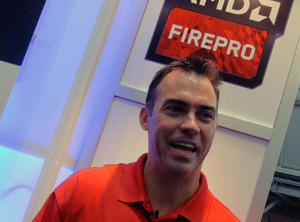Was ist neu in PTC Creo 3.0: Die neuen Features präsentiert von PTC's Vice-President Brian Thompson live on-stage auf der PTC Live Global
PTC Creo 3.0 ist das neueste große Release für alle PTC-User und parametrischen Design Experten. Mit Spannung wurden die neuesten Features auf der PTC Live Global in Boston erwartet. Ganz im Focus stand die "Unite Technology" - der Datenaustausch mit anderen CAD-Systemen. Tom Lansford war für CADplace in Bosten und schildert Ihnen hier die Highlights der Veranstaltung inklusive Live-Präsentation der neuesten Creo 3.0 Features, präsentiert von Brian Thompson, VP bei PTC. (engl.)
Brian Thompson took the stage in Boston to deliver live all the highlights of the new PTC Creo 3.0 version of 3D design software. The features include major areas such as:
- consolidation and collaboration in multi-CAD environments
- concept design development with a rich set of integrated tools
- flexible modeling
- productivity improvements across the Creo 3.0 Apps
First, the Unite Technology brings data compatibility with multiple different CAD vendor applications. This includes importing, opening, and saving models from CAD applications such as CATIA, SolidWorks, and Siemens NX. What is it that makes Unite Technology so useful and unique? Brian Thompson explains in the video below.
The Unite Technology delivers a big advantage to users working in multi-CAD environments. The difference is that PTC Creo 3.0 can open a foreign CAD file from NX, CATIA, or SolidWorks and treat it as if that model were a native Creo design file. The implications of this ability are many. This allows you to work with CAD files from suppliers early in the design process without the overhead of importing and managing that data - often repeated spending time and effort to maintain up-to-date design information. The modeling tools in PTC Creo allow you to integrate the foreign CAD file into your design with full geometric associativity you expect so that changes to the foreign CAD data will be detected and updated in your Creo designs.
To be specific, take a design of a truck cab which was created using CATIA. The Creo designer opens the Cab assembly with file open in a PTC Creo design session. The designer want to integrate the truck's tank and design the mounting for the tank. The initial tank design will come from a supplier working with SolidWorks. Creo 3.0 allows you to create a cross-CAD platform associativity and design the mounting for the tank in Creo with a robust association to the SolidWorks tank assembly.
This technology has implications for CAD consolidation. Rather than importing and consolidating every design file in a single, long, costly, and (nearly always) imperfect process, Unite Technology allows companies to work with foreign CAD data as native PTC Creo objects. Because the design information is not converted, no new business objects are created which need to be managed by the project team. Only at the point when changes must be made to the foreign design file and the choice is to make that change in PTC Creo, does Creo automatically convert the object. Another efficiency is that only the changed part is converted. The implication is that among the many objects in the assembly, only those which must be converted are converted. This optimizes your conversion process. Until PTC Creo 3.0, this was not possible.
All of the open, import, and conversion capabilities are all free-of-charge if you are on the support program.
Collaboration in a multi-CAD environment is enhanced as well with Unite Technology in PTC Creo 3.0
With PTC Creo 3.0 and the coming PTC Windchill 10.2m30 release, Windchill will proactively notify the designer if there are objects in the design session which are out-of-date. The designer can update the design and all the objects, whether they come from PTC Creo, NX, CATIA, or SolidWorks, are updated in the design together. This means that designers do not need to learn any new processes as the foreign CAD objects are treated just like Creo objects when the design updates occur.
Design Exploration Extensions provide one of the most interesting tools available for easily investigating design alternatives. The Design Exploration Extensions allows you to set check-points in your design and then explore a design alternative. Check-points can be set with a single click. The management of the design alternatives is very efficient since it stores the differences to the design at the check-point. It does not need to copy the entire design.
PTC Creo 3.0 comes out in July with rolling updates. PTC presented the schedule consisting of several steps including the release of
Links into the PTC Creo 3.0 video:
- Creo 3.0 Unite Technology
- CAD consolidation
- CAD collaboration
- Concept Design
- Creo Layout
- Creo Direct
- Creo Design Exploration
